Abstract
Estimation of ultimate bearing capacity (UBC) of pre-stressed high-strength concrete (PHC) pipe pile is critical for optimizing pile design and construction. In this study, a standard penetration test (SPT), static cone penetration test (CPT) and static load test (SLT) were carried out to assess, determine and compare the UBC of the PHC pipe pile embedded in saturated sandy layers at different depths. The UBC was calculated with three methods including the JGJ94-2008 method, Meyerhof method and Schmertmann method based on in-situ blow count (N) of SPT (SPT-N) which was higher than the values recommended in survey report regardless of pile length. The average UBC values calculated with cone-tip resistance and sleeve friction from CPTs was also higher than the value recommended in the survey report. Moreover, the actual UBC values directly obtained by load-displacement curves from SLTs were in line with the calculated values based on in-situ SPTs and CPTs, but approximately twice as high as the values recommended in the survey report regardless of pile length. For the SPT method, the application of bentonite mud in saturated sand layers is critical for the assessment of pile capacity in the survey phase, CPTs can provide reliable results regardless of soil characteristics and groundwater if the soil layer can be penetrated, and SLTs are necessary to accurately determine the UBC in complex stratum.
1. Introduction
Pile foundations as structural elements are widely applied to back up superstructures, such as high-rise buildings, large highway bridges, harbors, wind power plants and oil extraction facilities, by safely transferring the load from the shallow soft surface layers onto the deep firmer layer underground for the superstructure’s stability [1,2,3,4]. Determination of the ultimate bearing capacity (UBC) of designed piles is necessary and significant because that governs the safe geotechnical engineering design of pile foundations. Nevertheless, it is always a complex problem to create pile foundations under loading and precisely predict a pile’s load-bearing capacity for geotechnical design engineers [5]. As a result, numerous methods including experimental methods, numerical methods, and analytical methods, have been proposed to estimate pile behavior and pile load-bearing capacity [5,6,7,8,9,10]. Nevertheless, it is well established that the level of accuracy and consistency of the estimated bearing capacity is of prime importance for those methods; for example, the difference of estimated bearing capacity between the Meyerhof method and semi-empirical method [11]. Furthermore, the constructability, strength, and serviceability criteria of pile foundations must be considered in the design process. The reliable load-bearing capacity of the pile must be available for serviceability as well [5]. Therefore, the accurate evaluation of pile bearing capacity is still far from accomplished due to the complexity of the problems.
The theoretical solutions employing the bearing capacity to calculate the pile shaft and tip resistance involve setbacks caused by considerable uncertainty factors, such as installation method, stress history and soil compressibility [12]. The experimental solutions like the standard penetration test (SPT), static cone penetration test (CPT), and static load test (SLT), correlating in-situ tests results with pile bearing capacity are commonly used in evaluating load-bearing capacity of a single pile although they also involve shortcomings induced by both operator and test procedure. For SPT, it remains one of the most popular in-situ testing procedures, which is frequently used to estimate foundation design parameters [13]. However, it has substantially inherent variablility which cannot reflect soil compressibility, and is affected by many factors like the operator, drilling, hammer efficiency and blow rate etc. [12,14]. According to the specification, the blow count (N) of SPT (SPT-N), the number of blows to drive a sampler 300 mm in the ground, varies significantly due to the various experimental conditions and operating conditions in the preliminary investigation of the project site [15], and the SPT-N is often widely applied in predicting bearing capacity and assessing the quantificational risk of soil liquefaction [15,16,17]. For CPT, it is considered as one of the most useful field techniques for the soil characterizations because CPT is a robust, simple, fast, reliable, and economic test providing continuous soundings of subsurface soil and does not need extensive coring [1,18]. Generally, CPT is considered a model pile due to the resemblance between the cone penetrometer and pile, which consequently has extensive applications for geotechnical engineering [19]. Cone-tip resistance and sleeve friction are measured and recorded simultaneously when the tip penetrates the soil layer [2]. After acquisition of the cone penetration data, there are two approaches to apply CPT records for both drilled and driven piles’ design [2,19]. One is a direct approach in which the measured cone-tip resistance and sleeve friction are directly used for calculating pile bearing capacity [20,21,22,23,24,25,26,27], while the other is an indirect approach in which the measured CPT data are applied first to estimate the soil parameters, and then the estimated data are used to obtain the end bearing capacity as well as the unit skin friction [28,29]. Moreover, a CPTu-based enhanced unicorn method for pile capacity has been proposed, which estimated axial pile capacity for a wide variety of pile types installed in different assortments of geomaterials [30]. The development of a direct experimental SPT and CPT method is shown in Table 1.

Table 1.
Direct experimental methods for predicting the pile ultimate bearing capacity (UBC).
Loading statically on the pile until its failure is the most direct and reliable method in determining the load-bearing capacity of a single pile so far, although the major limitation of conducting SLT is that it is much more expensive and time-consuming [4]. Apart from that, high-strain dynamic testing of piles (HSDT) [32] based on one-dimensional wave propagation and provided by a pile driving analyzer (PDA), is an innovative method in predicting the bearing capacity of bored piles, and the bearing capacity has been proved to be in close agreement with that of SLT [33]. It is worth noting that a reasonable safety factor value is of the essence for those in-situ tests to obtain a solid foundation [34].
Considering the high cost of in-situ tests, artificial intelligence (AI) combining mathematics, algorithm, and creativity, has been introduced to establish AI-based predictive models of bearing capacity of piles in the last decade [4,35,36,37,38,39]. With the CPT results, two artificial neural networks (ANNs) and a nonlinear multiple regression model for predicting pile resistance were set up to predict pile resistance [2]. It has been proved that the application of artificial intelligence and predictive models are practical, feasible, and they can be regarded as fast tools in solving engineering problems [40]. Apart from that, a new on-site camera method based on node displacement with the biological mechanism of phagocytosis to correlate continuous images was developed to calculate the settlement of piles [41].
Apart from the in-situ test, numerical simulation methods have also been applied to study the bearing capacity. Chen et al. used a discrete element model (DEM) to assess the pile-sand interactions at the micro-scale [9]. Cai et al. used the finite element model (FEM) to calculate bearing capacity at the tip of the pile for different slope angles [10]. Józefiak et al. also adopted the FEM to obtain the pile bearing capacity and pile settlement of the soil–pile system [42]. For a broad group pile foundation, the field load test combined with numerical analysis are usually applied to estimate the ultimate performances of the pile foundation [43].
The pile properties are also of considerable significance to better evaluate the bearing capacity of the pile foundation. A new type of offshore oil and gas platform mixed pile was explored with the laboratory test program and the FEM, and the results show that the novel offshore foundation type is suitable for a wide range of sand conditions [44]. The impact of sand piles on improving the bearing capacity of soil foundations as well as controlling the settlement is studied by partially replacing sand piles with constraints [45]. Moreover, there are still many factors affecting the bearing capacity of the pile foundations, such as external sulfate attack, effective radius, and the elastic modulus of a pile. The ultimate bearing capacity (UBC) and failure characteristics of the pile are related to the shape of the pile cap and the strength of the pile body [46]. The degree of soil-plugging should be considered when the bearing capacity of the open-ended pile is studied [47]. The plugging effect of open-ended piles is highly influenced by the pile driving condition, soil condition, and pile geometry conditions [48]. Much work has focused on the prediction method and influence factors of pile bearing capacity; however, it remains challenging to accurately estimate the ultimate bearing capacity (UBC) of a single pile, especially in consideration of complex geological conditions in practice.
The purpose of this paper is to analyze the ultimate bearing capacity (UBC) of PHC piles embedded in saturated sandy layers. Three in-situ tests, including SPT, CPT, SLT, and the corresponding calculation methods of the ultimate bearing capacity of a single pile with data from various tests, are described to demonstrate the differences between in-situ results and values recommended in the survey report. The mechanism for these differences is also explored.
2. Ground Conditions
The in-situ tests were carried out in Nanchang Aerospace Industry Town, in the Jiangxi province of China, with multiple thick sandy layers and abundant groundwater. The plant before treatment was flat terrain, including paddy fields, ponds, roads, and creeks. Figure 1 shows the schematic diagram of the area and the soil profiles. As shown in Figure 1, a soft substratum (⑤) lies between coarse sand (④) and medium sand (⑥ & ⑦). To obtain a secure and stable foundation, the PHC pipe pile foundation was penetrated through the soft substratum (⑤) to the bearing stratum of medium sand (⑥ & ⑦) based on the geological exploration. However, it was difficult to penetrate the PHC pipe piles with a length of approximately 21 m down to the bearing layer (⑥ & ⑦) because of the existence of dense coarse sand (④) with a variable thickness of 5~8 m. It is necessary to conduct in-situ tests to find the bearing capacity characteristics of a single PHC pipe pile embedded in the bearing layer at different depths, which provides a reliable basis for subsequent optimization of the design and construction of PHC pipe piles. As shown in Figure 1, the typical area between A-A’ and B-B’ was selected as the in-situ test area. In this study, the primary purposes were to obtain the vertical UBC of a single pile when the bearing stratums are coarse sand (④) and medium sand (⑥ & ⑦), respectively, and to acquire the ultimate skin friction of single PHC pipe piles embedded in medium sand (⑥ & ⑦).
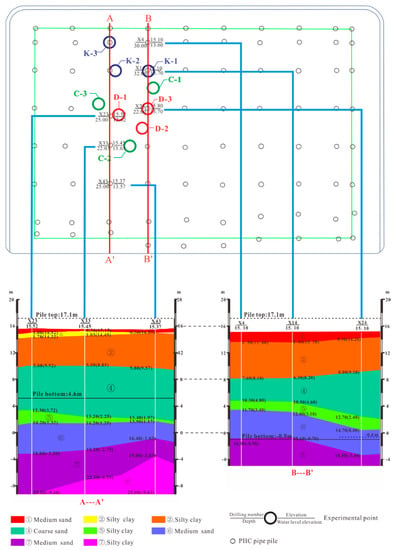
Figure 1.
Schematic diagram of plant area and geological cross-section with the exploratory boreholes.
3. Design of In-Situ Test
3.1. SPT
The SPT method was conducted according to the testing specifications [49] to evaluate the bearing capacity during the engineering survey phase. Figure 2a shows the schematic of the standard penetrator. Nine drilling holes, including SPT-1#, SPT-2#, SPT-3#, SPT-4#, SPT-5#, SPT-6 #, SPT-7#, SPT-8#, and SPT-9# were selected in the area between A-A’ and B-B’ in Figure 1. During the in-situ SPT, the pit was dug around the drilling hole, and 300 mesh bentonite powder was poured into the pit to make bentonite mud, which is different from the SPT performed in survey phase. The mud was hydrated for 24 h, its average specific gravity was 1.272 g/cm3, and the viscosity was 15.86 s, as shown in Figure 2b. A protective cylinder with an outer diameter of 127 mm and a length of 3 m was installed at the top of drilling holes to prevent the hole from collapsing. During the SPT test, the standard penetrator was impacted into the tested layer for 15 cm and then impacted into the layer every 10 cm for a total of 30 cm, as shown in Figure 2a. The depth of the tested layer and groundwater, as well as the SPT blow count (SPT-N) of each 10 cm footage, were recorded accordingly three times. Figure 2c shows the SPT in situ.
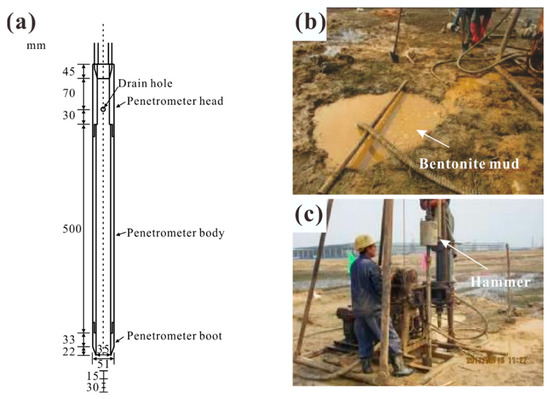
Figure 2.
(a) Schematic of penetrator; (b) Bentonite mud preparation; (c) standard penetration test (SPT) testing.
There are mainly three methods adopted for calculation of UBC of a single pile based on SPT-N:
(1) The JGJ94-2008 method [50]. The ultimate axial pile capacity () consists of the end bearing capacity of the pile () and the shaft friction capacity (). The is calculated as the product of the pile end area () and unit end bearing (). The is calculated as the product of the outer pile shaft area (), and the unit skin friction (). The general formula of ultimate axial pile capacity is given as follows:
where is pile perimeter (m); is the average unit skin friction (kPa) of soil layer ; is the pile length (m) interfacing with layer ; is the number of soil layers along the pile shaft.
(2) The Meyerhof method [51]. Meyerhof put forward empirical correlations between the SPT-N and the bearing capacity of piles as follows:
where is ultimate axial capacity (kPa); is the cross-sectional area of the pile tip (m2); is ultimate stress (kPa); is pile perimeter (m); is pile length (m); is average unit skin resistance (kPa); L and D are pile length and pile diameter (m), respectively; is average SPT-N value almost 10D above and 4D below pile tip; is average SPT (N) value.
(3) The Schmertmann method [52]. Schmertmann used the N value to determine the ultimate end bearing capacity and ultimate shaft friction capacity, as shown in Table 2.

Table 2.
Schmertmann method.
3.2. CPT
Figure 3a shows the schematic of the static CPT, consisting of a double bridge probe at the lower end of a high-strength and stainless steel pipe segments in succession. The double bridge probe comprised a cone tip, which was 10 cm2 in basal area (35.7 mm in diameter) with an apex angle of 60°, as presented in Figure 3b. The 10 CPT test points within 2 m and corresponding to SPT test points (CPT-1#, CPT-2#, CPT-3#, CPT-4#, CPT-5#, CPT-6#, CPT-7#, CPT-8#, CPT-9#, CPT-10#), were selected, respectively. Four ground anchors with a length of 1.5 m and a diameter of 35 cm of the anchor blade were penetrated into the ground. Two trucks provided counterforce for the CPT method, as shown in Figure 3c. The double bridge probe and the metal pipes were pushed down into 1 m below the ground and then raised 10 cm to observe the zero position movement. After that, the data were cleared, and the probe was pressed back to the original position to begin the formal penetration at a constant speed of 2 cm/s. Some soundings could not be penetrated to the long pile tip because of the dense over-consolidated sand of the coarse sand layers (④). Therefore, a drill machine was used to penetrate through the coarse sand layer (④) until the long probe toe could reach to the medium sand (⑥ & ⑦), and then the CPT could be conducted in the soil layers below. As penetration was ongoing, cone-tip resistance ( in MPa per unit area at the cone tip) and sleeve friction ( in kPa per unit area of the sleeve) were measured and recorded. The friction ratio () could be obtained as follows [53]:
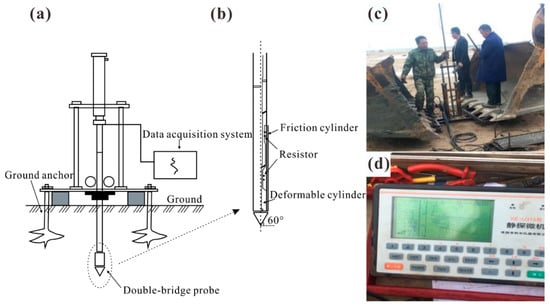
Figure 3.
(a) Schematic of static cone penetration test: (b) Schematic of double bridge probe; (c) Reaction system; (d) Data acquisition system.
The formula for determining the UBC of a single PHC pipe pile based on the CPT results of the double bridge probe is as follows [50]:
where is average unit skin friction of a double bridge probe induced by soil layer ; is the correction coefficient of skin friction induced by sandy soil layer ; is correction coefficient of pile tip resistance (for saturated sand, ); is cone-tip resistance.
3.3. SLT
Three types of PHC piles were driven into different bearing soil layers, including coarse sand (④) and medium sand (⑥ & ⑦). The distribution of the investigated PHC types is illustrated in Figure 1, and the characteristics of the PHC piles are presented in Table 3. The D-type pile with a length of 12.5 m was embedded in coarse sand (④). Both C-type and K-type PHC piles were penetrated into medium sand (⑥ & ⑦). The soil below the K-type PHC pile tip was hollowed out with a drill to obtain pure shaft friction capacity, as shown in Figure 4(Aa). The test pile installation process is presented in Figure 4(Ab,Ac). Before SLTs, the pipe heads were pre-treated to protect the pile head from damage in the SLT. For C-type and D-type PHC pile pipes, the pile heads were cut, and new reinforced concrete pile heads with a diameter of 600 mm were fabricated, as shown in Figure 4B. For K-type PHC pile pipes, the pile heads were strengthened by the bind with hoops because the counterforce could only be provided by skin friction, as shown in Figure 4C.

Table 3.
Characteristics of investigated pre-stressed high-strength concrete (PHC) piles.
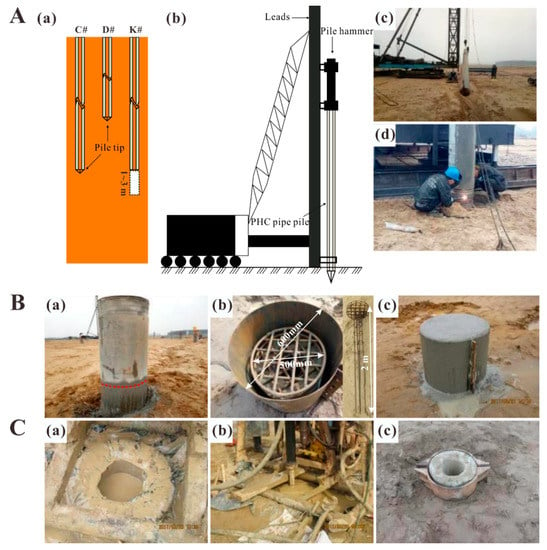
Figure 4.
(A): PHC pipe pile types (C-type, D-type, and K-type) and schematic figure of pile driving method by hammer; (B): Pile cap making for C-type and D-type PHC pipe piles: (C): Pile cap making for K-type PHC pipe piles.
Figure 5 shows the schematic figure of the SLT. The SLT was performed with a loading method for individual piles step-by-step, in line with a local pile testing specification [54]. The load applied on the pile head was increased by 10% of the design load, and the load of the first step was twice that of the other steps. Settlement of pile head was measured and recorded at intervals of 5 min, 10 min, 15 min, 15 min, 15 min, 30 min and so on after each loading step until the settlement is smaller than 0.1 mm within two hours. The corresponding pile head settlement was monitored and recorded with four digital dial gauges fixed to the reference beams. Most of the investigated piles in this study failed before reaching the maximum load, and the pile capacity could be determined from load-displacement curves obtained from SLTs.

Figure 5.
Schematic of static load test. (a) Schematic of static load test; (b) photograph of static load test in the test; (c) hydraulic jack and dial gauge in the test.
4. Results
4.1. Bearing Capacity Based on SPT
Figure 6 shows the soil profile and corresponding blow counts (N) of SPT (SPT-N) at different testing points. The blow counts (N) were adopted to calculate the UBC of a single pile in this study based on the JGJ94-2008 method [50], Meyerhof method [51] and Schmertmann method [52], respectively. The calculated values were compared with that given in the survey report, as shown in Figure 7. For 21 m long PHC pipe piles embedded in medium sand (⑥ & ⑦), the recommended values of UBC in survey report are in the range of 2191~3055 kN, while the UBC values calculated with the JGJ94-2008 method, Meyerhof method, and Schmertmann method were in range of 3570~4560 kN, 3437~5268 kN, 3316~5283 kN, respectively. The corresponding ratios of calculated values to the recommended value in the survey report are in the range of 1.30~2.10, 1.22~2.35, and 1.17~2.29, respectively. Based on SPT-1#, SPT-2#, and SPT-3#, for short PHC pipe piles with a length of 12.5 m embedded in coarse sand (④), the recommended values of UBC in the report are in the range of 1547~1568 kN, while the UBC values calculated with the JGJ94-2008 method, Meyerhof method, and Schmertmann method, were in the range of 2828~3087 kN, 1799~3776 kN, 3304~5009 kN, respectively. The corresponding ratios of the calculated values to the report’s recommended value are in the range of 1.80~2.00, 1.15~2.41, and 2.11~3.24, respectively. It is evident that all calculated values are bigger than the recommended values with no regard to pile length, and the value recommended in the survey report is rather conservative, which cannot truly reflect the formation characteristics on bearing capacity.
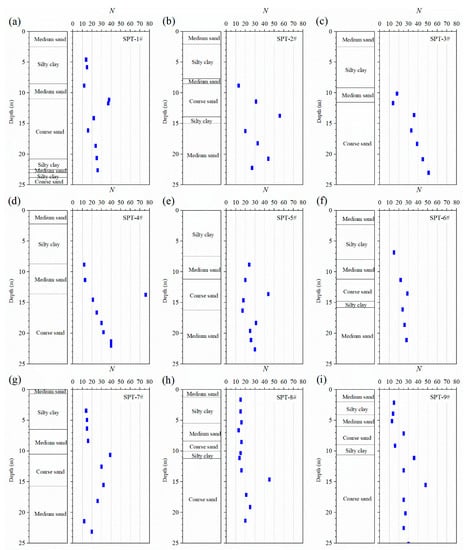
Figure 6.
Soil profile and standard penetration test results (SPT-N). (a) SPT-1#; (b) SPT-2#; (c) SPT-3#; (d) SPT-4#; (e) SPT-5#; (f) SPT-6#; (g) SPT-7#; (h) SPT-8#; (i) SPT-9#.
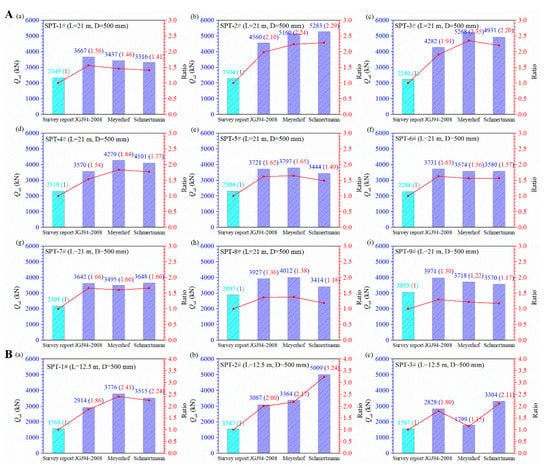
Figure 7.
(A) The ultimate bearing capacity of long PHC pipe pile (L = 21 m, D = 500 mm); (B) The ultimate bearing capacity of short PHC pipe pile (L = 12.5 m, D = 500 mm).
4.2. Bearing Capacity Based on CPT
As illustrated in Figure 8, the cone tip resistance, sleeve friction, and friction ratio of CPTs, measured near the test PHC pipe piles, shows that the measured parameters profiles of the different CPTs were in good agreement with each other in the same soil layers. The cone-tip resistance values are mostly in the range of 0~22 MPa in coarse sand (④) and medium sand (⑥ & ⑦) below. The sleeve friction values were mostly in the range of 0~220 kPa in coarse sand (④) and medium sand (⑥ & ⑦) below. The UBC values of a single pile were calculated for long PHC pipe piles with a length of 21 m and short PHC pipe piles with a length of 12.5 m, respectively, based on the JGJ94-2008 method, as shown in Figure 9. The average UBC value for a single short PHC pipe pile in coarse sand was 2766 kN, while the average UBC value for a single long PHC pipe pile in medium sand was 3824 kN. It can be seen that the calculated UBC values with the CPTs data are close to the average value of the single pile UBC values calculated with the in-situ SPTs.
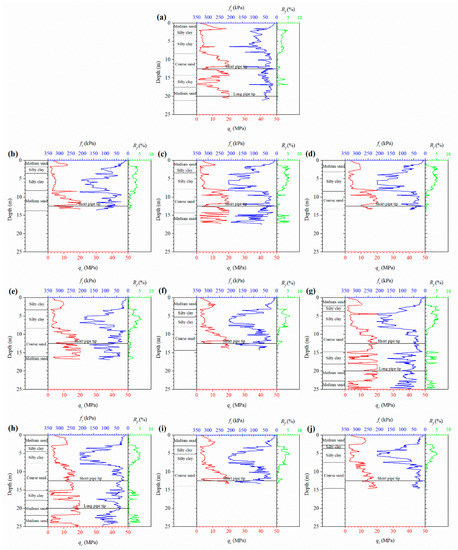
Figure 8.
Cone penetration test (CPT) results (a) CPT-1#; (b) CPT-2#; (c) CPT-3#; (d) CPT-4#; (e) CPT-5#; (f) CPT-6#; (g) CPT-7#; (h) CPT-8#; (i) CPT-9#; (j) CPT-10#.
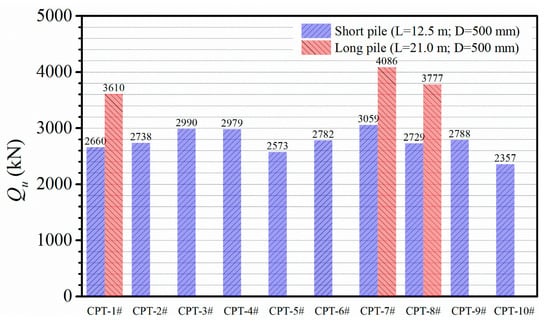
Figure 9.
Ultimate bearing capacity based on CPT results.
4.3. Bearing Capacity Based on SLT
The complete load-settlement (Q-S) responses of the tested PHC pipe piles are presented in Figure 10, and the experimental results of different piles are listed in Table 4. The maximum load of C-type PHC pipe piles (C-1#, C-2#, C-3#) embedded in medium sand (⑥ & ⑦) was 6300 kN, and the corresponding pile head settlement was 55.54 mm. The standard value of the ultimate load was 4900 kN, and the characteristic value was 2450 kN. D-type PHC pipe piles (D1#, D2#, D3#) embedded in coarse sand (④) and K-type PHC pipe piles (K1#, K2#, K3#) embedded in medium sand (⑥ & ⑦) were loaded to 4500 kN and 5000 kN, respectively. The corresponding maximum pile head displacements of D-type piles and K-type piles were 68.56 mm and 60.78 mm, respectively. The standard value of the ultimate load for D-type and K-type piles are 3500 kN and 4500 kN, respectively, and the characteristic values were 1750 kN and 2250 kN, respectively.
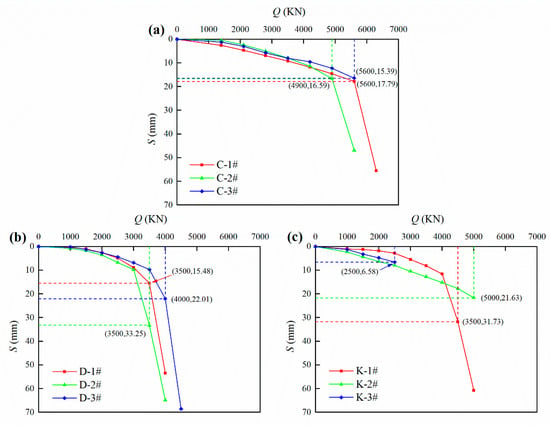
Figure 10.
Curves of PHC pipe piles (a) C-type; (b) D-type; (c) K-type.

Table 4.
Experimental results of different piles.
5. Discussion
In-situ tests, including SPT, CPT, and SLT, were conducted to estimate the UBC of a single PHC pipe pile embedded in the saturated sandy layer in different depths. The average values of skin friction capacity, end-bearing capacity, and UBC obtained with these in-situ tests were comprehensively compared with the values recommended in the survey report, as shown in Figure 11. All values of UBC based on in-situ tests were over 1.5 times higher than the UBC value recommended in the survey report regardless of pile length, while the tested values were similar. The UBC value recommended in the survey report is calculated by the JGJ94-2008 method with blow count (N) of SPT (SPT) in the survey phase. Hence, the difference between the calculated UBC and recommended UBC might be caused by SPT-N. The SPT-N in the survey phase is compared with that in the in-situ test, as shown in Figure 12. It can be seen that the SPT-N values in the survey report are less than 25, while most of the SPT-N values in the in-situ test are higher than 25 at the position of 10 m below ground surface where coarse sand and medium sand lies. The compactness of the tested soil layers based on blow counts in the survey report varies from slight denseness to medium denseness. In contrast, the compactness of the tested soil layers based on in-situ SPTs mainly varies from medium denseness to heavy denseness, especially for soil layers at the position of 10 m below ground surface, which might be caused by the bentonite mud technology. The bentonite mud technology was not adopted in the survey phase, and the drilling wall might collapse during SPTs, leading to low blow counts (SPT-N). In contrast, the drilling wall did not collapse during SPTs in the in-situ SPTs due to the adoption of bentonite mud technology, reflecting the real density and strength of the tested soil layers, especially for saturated sandy layers with cohesionless characteristics. It indicates that the bentonite mud technology is significant and necessary for accurate estimation of the UBC of pile foundations.
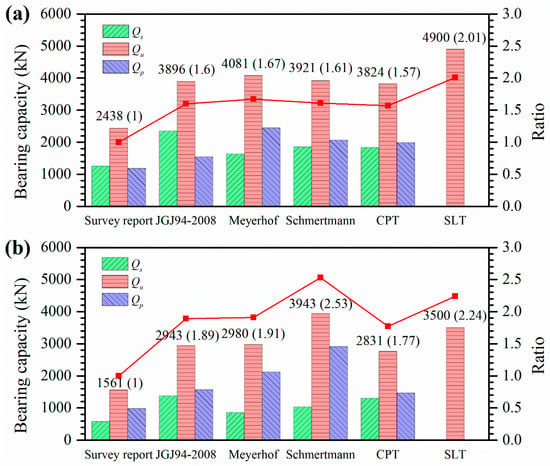
Figure 11.
Comparison of bearing capacity. (a) Long piles (L = 21 m); (b) short piles (L = 12.5 m).

Figure 12.
Penetration depth versus the blow count (N) of the standard penetration test (SPT) (SPT-N).
6. Conclusions
In this study, a group of in-situ tests including the SPT, CPT and SLT were carried out to investigate and evaluate the UBC of a single PHC pipe pile embedded in saturated coarse sand and medium sand. Based on the analysis of the test results, the main findings specific to the soil layers and in-situ tests for PHC piles can be summarized as follows:
- (1)
- For in-situ SPTs, three calculation methods, including the JGJ94-2008 method, Meyerhof method, and Schmertmann method, were adopted to calculate the UBC of a single PHC pipe pile based on in-situ SPTs. The calculated results of the three methods were similar, while the calculated UBC values were approximately 1.17~2.35 times and 1.15~3.24 times as much as the recommended values in the survey report for long piles with a length of 21 m and short piles with a length of 12.5 m, respectively.
- (2)
- The CPT with a double bridge probe was conducted to obtain the cone-tip resistance and sleeve friction close to SPT test points. The results were similar to the results calculated with in-situ SPTs, and the average value was 1.57 times and 1.81 times bigger than the value recommended in the survey report for long PHC pipe piles embedded in medium sand and short PHC pipe piles embedded in coarse sand, respectively.
- (3)
- The SLTs were conducted for three types of PHC pipe piles. It shows that the UBC based on SLTs was similar to the results acquired with SPTs and CPTs. However, it was 2.01 times and 2.24 times as much as the values recommended in the survey report for long and short PHC piles, respectively.
- (4)
- The conservative values recommended in the survey report were also calculated by the JGJ94 method based SPTs in the survey. The SPT blow counts (SPT-N) based on in-situ SPTs increased dramatically compared to the blow-count values in the survey report, especially in saturated sand layers at the position of 10 m below the ground. It might be caused by bentonite mud technology, which plays a significant role in preventing the drilling wall from collapsing.
Several evaluation methods were adopted and carried out in this study to study the UBC of a single PHC pile embedded in saturated sand layers. The application of bentonite mud technology in SPTs in a saturated sandy layer with cohesionless characteristics can provide more reliable parameters for evaluation of the UBC of a pipe foundation in the survey phase. CPTs can provide reliable results regardless of soil characteristics and groundwater as long as the soil layer could be penetrated. SLTs are necessary to accurately determine the UBC of pile foundation in complex stratum.
Author Contributions
Conceptualization, Y.W.; methodology, Y.W.; software, Y.W., J.L. (Jianguang Li); validation, J.L. (Jiawang Li), formal analysis, Y.W.; investigation, Y.W., J.L. (Jiawang Li), Z.K.; resources, D.W., J.L. (Jianguang Li); writing-original draft preparation, Y.W., J.L. (Jiawang Li), Z.K., T.W.; supervision, D.W., Y.J.; project administration, D.W.; Founding acquisition, Y.W., Y.J. All authors have read and agreed to the published version of the manuscript.
Funding
This research received no external funding.
Acknowledgments
The authors would like to express their special thanks to AVIC Institute of Geotechnical Engineering Co., LTD. for allowing the field test and these data obtained on the site to be published. The research work described herein was also founded by the China Postdoctoral Science Foundation (Grant Nos. 2020M670604), the National Key Research and Development Program of China (Grant Nos. 2017YFC0805008), and the National Nature Science Foundation of China (NSFC) (Grant Nos. 41790434).And the APC was funded by (2020M670604). The financial supports are gratefully acknowledged.
Conflicts of Interest
The authors declare no conflict of interest.
References
- Cai, G.; Liu, S.; Tong, L.; Du, G. Assessment of direct CPT and CPTU methods for predicting the ultimate bearing capacity of single piles. Eng. Geol. 2009, 104, 211–222. [Google Scholar] [CrossRef]
- Baziar, M.H.; Kashkooli, A.; Saeedi-Azizkandi, A. Prediction of pile shaft resistance using cone penetration tests (CPTs). Comput. Geotech. 2012, 45, 74–82. [Google Scholar] [CrossRef]
- Dai, G.; Gong, W. Application of bi-directional static loading test to deep foundations. J. Rock Mech. Geotech. Eng. 2012, 4, 269–275. [Google Scholar] [CrossRef]
- Momeni, E.; Nazir, R.; Armaghani, D.J.; Maizir, H. Prediction of pile bearing capacity using a hybrid genetic algorithm-based ANN. Measurement 2014, 57, 122–131. [Google Scholar] [CrossRef]
- Nejad, F.P.; Jaksa, M.B.; Kakhi, M.; McCabe, B. Prediction of pile settlement using artificial neural networks based on standard penetration test data. Comput. Geotech. 2009, 36, 1125–1133. [Google Scholar] [CrossRef]
- Momeni, E.; Maizir, H.; Gofar, N.; Nazir, R. Comparative Study on Prediction of Axial Bearing Capacity of Driven Piles in Granular Materials. J. Teknol. 2013, 61, 15–20. [Google Scholar] [CrossRef]
- Li, J.; Wang, X.; Guo, Y.; Yu, X. (Bill) Vertical bearing capacity of the pile foundation with restriction plate via centrifuge modelling. Ocean Eng. 2019, 181, 109–120. [Google Scholar] [CrossRef]
- Zhou, J.-J.; Yu, J.; Gong, X.-N.; Zhang, R.-H.; Yan, T.-L. Influence of soil reinforcement on the uplift bearing capacity of a pre-stressed high-strength concrete pile embedded in clayey soil. Soils Found. 2019, 59, 2367–2375. [Google Scholar] [CrossRef]
- Chen, Y.; Deng, A.; Lu, F.; Sun, H. Failure mechanism and bearing capacity of vertically loaded pile with partially-screwed shaft: Experiment and simulations. Comput. Geotech. 2020, 118, 103337. [Google Scholar] [CrossRef]
- Cai, Y.; Xu, B.; Cao, Z.; Geng, X.; Yuan, Z. Solution of the ultimate bearing capacity at the tip of a pile in inclined rocks based on the Hoek-Brown criterion. Int. J. Rock Mech. Min. Sci. 2020, 125, 104140. [Google Scholar] [CrossRef]
- Momeni, E. Axial Bearing Capacity of Piles and Modelling of Distribution of Skin Resistance with Depth. Master’s Thesis, Universiti Teknologi Malaysia, Skudai, Johor, Malaysia, 2012. [Google Scholar]
- Alkroosh, I.S.; Bahadori, M.; Nikraz, H.; Bahadori, A. Regressive approach for predicting bearing capacity of bored piles from cone penetration test data. J. Rock Mech. Geotech. Eng. 2015, 7, 584–592. [Google Scholar] [CrossRef]
- Zhang, N.; Arroyo, M.; Ciantia, M.O.; Gens, A.; Butlanska, J. Standard penetration testing in a virtual calibration chamber. Comput. Geotech. 2019, 111, 277–289. [Google Scholar] [CrossRef]
- Abu Kiefa, M.A. General Regression Neural Networks for Driven Piles in Cohesionless Soils. J. Geotech. Geoenviron. Eng. 1998, 124, 1177–1185. [Google Scholar] [CrossRef]
- Kuo, Y.-S.; Chong, K.-J.; Tseng, Y.-H.; Hsu, C.-W.; Lin, C.-S. Assessment on liquefaction potential of seabed soil in Chang-Bin Offshore wind farm considering parametric uncertainty of standard penetration tests. Eng. Geol. 2020, 267, 105497. [Google Scholar] [CrossRef]
- Seed, H.B.; Idriss, I.M. Simplified procedure for evaluating soil liquefaction potential. J. Soil Mech. Found. Div. ASCE 1971, 97, 1249–1273. [Google Scholar]
- Kanth, S.T.G.R.; Dash, S.K. Stochastic modeling of SPT n-value and evaluation of probability of liquefaction at guwahati city. J. Earthq. Tsunami 2008, 2, 175–196. [Google Scholar] [CrossRef]
- Zhang, X.; Lin, C.-M.; Dalrymple, R.W.; Gao, S.; Canas, D.T. Use of the Cone Penetration Testing (CPT) method to interpret late Quaternary tide-dominated successions: A case study from the eastern China coastal plain. Cont. Shelf Res. 2018, 161, 49–57. [Google Scholar] [CrossRef]
- Eslami, A.; Moshfeghi, S.; Molaabasi, H.; Eslami, M.M. CPT and CPTu Applications for Deep Foundation–Bearing Capacity. In Piezocone and Cone Penetration Test (CPTu and CPT) Applications in Foundation Engineering; Elsevier Butterworth-Heinemann: Oxford, UK, 2020; pp. 183–231. [Google Scholar] [CrossRef]
- Aoki, N.; De Alencar, D. An approximate method to estimate the bearing capacity of piles. In Proceedings of the 5th Pan-American Conference of Soil Mechanics and Foundation Engineering, Buenos Aires, Argentina, 17–22 November 1975; pp. 367–376. [Google Scholar]
- Clisby, M.B.; Scholters, R.M.; Corey, M.W.; Cole, H.A.; Teng, P.; Webb, J.D. An Evaluation of Pile Bearing Capacities; Mississippi State Highway Department: Jackson, MS, USA, 1978.
- Schmertmann, J.H. Guidelines for Cone Penetration Test, Performance and Design; Report FHWA-TS-78-209; Department of Transportation: Washington, DC, USA, 1978.
- De Kuiter, J.; Beringen, F.L. Pile foundations for large North Sea structures. Mar. Geotechnol. 1979, 3, 267–314. [Google Scholar] [CrossRef]
- Philipponnat, G. Methode pratique de calcul d’um pieu isole a l’aide du penetrometre statique. Rev. Fr. Geotech. 1980, 10, 55–64. [Google Scholar] [CrossRef]
- Bustamante, M.; Gianeselli, L. Pile Bearing Capacity Prediction by Means of Static Penetrometer CPT. In Proceedings of the 2nd European Symposium on Penetration Testing, ESOPT-II, Amsterdam, The Netherlands, 24–27 May 1982; pp. 493–500. Available online: https://www.cpt-robertson.com/PublicationsPDF/Pile%20Bearing%20Cap%2CCPT-LCPC%20Method-Bustamonte%20et%20al-ESOPT2-198.pdf (accessed on 1 June 2020).
- Tumay, M.T.; Fakhroo, M. Friction Pile Bearing Capacity Prediction in Cohesive Soils Using Electric Quasi-Static Penetration Tests; Interim Research Report 1; Louisiana Department of Transportation and Development: Baton Rouge, LA, USA, 1982.
- Prince, G.; Wardle, I.F. A comparison between cone penetration test results and the performance of small diameter instrumented piles in stiff clay. In Proceedings of the 2nd European Symposium on penetration testing, Amsterdam, The Netherlands, 24–27 May 1982; pp. 775–780. [Google Scholar]
- Eslami, A.; Fellenius, B.H. Pile capacity by direct CPT and CPTu methods applied to 102 case histories. Can. Geotech. J. 1997, 34, 886–904. [Google Scholar] [CrossRef]
- Ardalan, H.; Eslami, A.; Nariman-Zadeh, N. Piles shaft capacity from CPT and CPTu data by polynomial neural networks and genetic algorithms. Comput. Geotech. 2009, 36, 616–625. [Google Scholar] [CrossRef]
- Niazi, F.S.; Mayne, P.W. CPTu-based enhanced UniCone method for pile capacity. Eng. Geol. 2016, 212, 21–34. [Google Scholar] [CrossRef]
- Meyerhof, G.G. Penetration tests and bearing capacity of cohesionless soils. J. Soil Mech. Found. Div. 1956, 82, 1–19. [Google Scholar]
- ASTM D 4945-17, Standard Test Method for High-Strain Dynamic Testing of Deep Foundations; ASTM International: West Conshohocken, PA, USA, 2017.
- Likins, G.; Rausche, F. Correction of CAPWAP with Static Load Tests. In Procedings of the Seventh International Conference on Application of Stress Wave Theory to Piles; The Institute of Engineers Malaysia: Kuala Lumpur, Malaysia, 2004; pp. 153–165. Available online: https://www.pile.com/wp-content/uploads/2017/03/SW2004-SP08-CW_Correlation_final.pdf (accessed on 1 June 2020).
- Abu-Farsakh, M.Y.; Titi, H.H. Assessment of Direct Cone Penetration Test Methods for Predicting the Ultimate Capacity of Friction Driven Piles. J. Geotech. Geoenviron. Eng. 2004, 130, 935–944. [Google Scholar] [CrossRef]
- Shahin, M.A.; Jaksa, M.B.; Maier, H.R. Artificial neural network application in geotechnical engineering. Aust. Geomech. J. 2001, 36, 49–62. [Google Scholar]
- Roosta, M.; Ghaedi, M.; Daneshfar, A.; Sahraei, R.; Asghari, A. Optimization of the ultrasonic assisted removal of methylene blue by gold nanoparticles loaded on activated carbon using experimental design methodology. Ultrason. Sonochemistry 2014, 21, 242–252. [Google Scholar] [CrossRef]
- Roosta, M.; Ghaedi, M.; Shokri, N.; Daneshfar, A.; Sahraei, R.; Asghari, A. Optimization of the combined ultrasonic assisted/adsorption method for the removal of malachite green by gold nanoparticles loaded on activated carbon: Experimental design. Spectrochim. Acta Part A Mol. Biomol. Spectrosc. 2014, 118, 55–65. [Google Scholar] [CrossRef]
- Ghaedi, M.; Ansari, A.; Habibi, M.; Asghari, A. Removal of malachite green from aqueous solution by zinc oxide nanoparticle loaded on activated carbon: Kinetics and isotherm study. J. Ind. Eng. Chem. 2014, 20, 17–28. [Google Scholar] [CrossRef]
- Shahin, M.A. A review of artificial intelligence applications in shallow foundations. Int. J. Geotech. Eng. 2014, 9, 49–60. [Google Scholar] [CrossRef]
- Shahin, M.A. State-of-the-art review of some artificial intelligence applications in pile foundations. Geosci. Front. 2016, 7, 33–44. [Google Scholar] [CrossRef]
- Raza, A.; Qureshi, A.M.; Saleem, M.Q.; Maqbool, S. Phagocytosis-based camera-in-situ method for pile load testing. Autom. Constr. 2014, 45, 33–41. [Google Scholar] [CrossRef]
- Józefiak, K.; Zbiciak, A.; Maślakowski, M.; Piotrowski, T. Numerical Modelling and Bearing Capacity Analysis of Pile Foundation. Procedia Eng. 2015, 111, 356–363. [Google Scholar] [CrossRef]
- Teramoto, S.; Niimura, T.; Akutsu, T.; Kimura, M. Evaluation of ultimate behavior of actual large-scale pile group foundation by in-situ lateral loading tests and numerical analysis. Soils Found. 2018, 58, 819–837. [Google Scholar] [CrossRef]
- Spagnoli, G.; Scheller, P.; Doherty, P. In situ and laboratory tests on a novel offshore mixed-in-place pile for oil and gas platforms. J. Pet. Sci. Eng. 2016, 145, 502–509. [Google Scholar] [CrossRef]
- Nazir, A.; Azzam, W.R. Improving the bearing capacity of footing on soft clay with sand pile with/without skirts. Alex. Eng. J. 2010, 49, 371–377. [Google Scholar] [CrossRef]
- Phutthananon, C.; Jongpradist, P.; Yensri, P.; Jamsawang, P. Dependence of ultimate bearing capacity and failure behavior of T-shaped deep cement mixing piles on enlarged cap shape and pile strength. Comput. Geotech. 2018, 97, 27–41. [Google Scholar] [CrossRef]
- Jeong, S.; Ko, J.; Won, J.; Lee, K. Bearing capacity analysis of open-ended piles considering the degree of soil plugging. Soils Found. 2015, 55, 1001–1014. [Google Scholar] [CrossRef]
- Jafari, M.; Gharsallaoui, H.; Victor, K.H.; Holeyman, A. End bearing response of open-ended pipe piles embedded in rock. Int. J. Rock Mech. Min. Sci. 2019, 119, 46–57. [Google Scholar] [CrossRef]
- GB/T 50213. Standard for Geotechnical Testing Method. National Standard of the People’s Republic of China. 2019. Available online: http://www.waizi.org.cn/bz/66863.html (accessed on 2 August 2019).
- JGJ 94. Technical Code for Building Pile Foundations. National Standard of the People’s Republic of China. 2008. Available online: http://www.doc88.com/p-8969117080669.html (accessed on 1 June 2020).
- Kézdi, Á.; Rétháti, L. Bearing capacity and settlement of pile foundations. Soil Mech. Earthworks Found. Highw. Eng. 1988, 102, 183–226. [Google Scholar] [CrossRef]
- Schmertmann, J. Penetration testing in USA. Int. J. Rock Mech. Min. Sci. Géoméch. Abstr. 1976, 13, A111. [Google Scholar] [CrossRef]
- Lafuerza, S.; Canals, M.; Casamor, J.L.; Devincenzi, J. Characterization of deltaic sediment bodies based on in situ CPT/CPTU profiles: A case study on the Llobregat delta plain, Barcelona, Spain. Mar. Geol. 2005, 222–223, 497–510. [Google Scholar] [CrossRef]
- DBJ50-047. Code for Design of Building Foundation. Provincial Standard of Chongqing. 2006. Available online: https://www.doc88.com/p-0748393617481.html (accessed on 1 June 2020).
© 2020 by the authors. Licensee MDPI, Basel, Switzerland. This article is an open access article distributed under the terms and conditions of the Creative Commons Attribution (CC BY) license (http://creativecommons.org/licenses/by/4.0/).